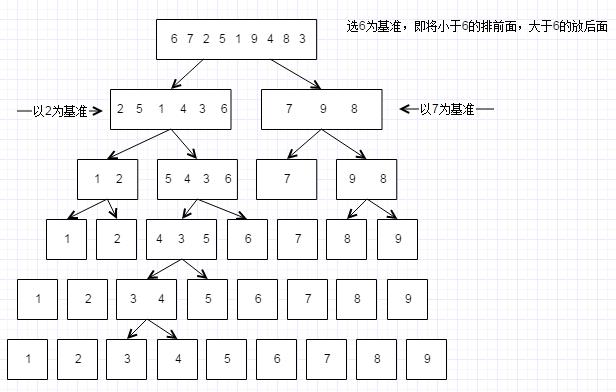算法概述:
与归并排序一样,快速排序也是基于分治思想的一种应用。对于包含n个数的输入数组来说,快速排序是一种最坏情况时间复杂度为O(n²)的排序算法。虽然最坏情况时间复杂度很差,但是快速排序通常是实际排序应用中最好的选择,因为它的平均性能非常好:它的期望时间是O(nlgn)且隐含的常数因子非常小,能够进行原址排序,甚至在虚存环境也能很好的工作。
算法步骤:
1、分解。从数组中,选择一个元素作为基准,将数组中小于基准元素的排到基准之前,大于的排到基准之后;
2、递归。分别递归排序较大元还给的子数组与较小的元素的子数组,直至为0或一个元素,即不需要排序;
3、因为子数组都是原址排序,不需要进行合并;
示意图:

上图切分是原地切分,需要一个辅助数组,但切分后将辅助数组复制回原数组会有开销,所以一般采用下面这种切分方式:

c#代码实现:(非原地切分)
public class quick { public int[] a = { 6, 7, 2, 5, 1, 9, 4, 8, 3 }; public void Sort() { Sort(a, 0, a.Length - 1); } public void Sort(int[] a, int low, int high) { if (high <= low) return; int mid = splitSort(a, low, high); Sort(a, low, mid - 1); Sort(a, mid + 1, high); } public int splitSort(int[] a, int low, int high) { int v = a[low]; int i = low; int j = high + 1; while (true) { while (a[++i] < v && i < high); while (a[--j] > v && j > 0) ; if (i >= j) break; int temp = a[i]; a[i] = a[j]; a[j] = temp; } int temp1 = a[low]; a[low] = a[j]; a[j] = temp1; return j; } }
erlang代码实现:
sort([]) -> []; sort(List) when is_list(List) -> sort2(List). sort2([]) -> []; sort2([Value | List]) -> {LeftList, RightList} = spilt_sort(List, Value, [], []), sort2(LeftList) ++ [Value]++ sort2(RightList). spilt_sort([], _Value, LeftAcc, RightAcc) -> {LeftAcc, RightAcc}; spilt_sort([H | List], Value, LeftAcc, RightAcc) when H > Value -> spilt_sort(List, Value, LeftAcc, [H | RightAcc]); spilt_sort([H | List], Value, LeftAcc, RightAcc) -> spilt_sort(List, Value, [H | LeftAcc], RightAcc).


